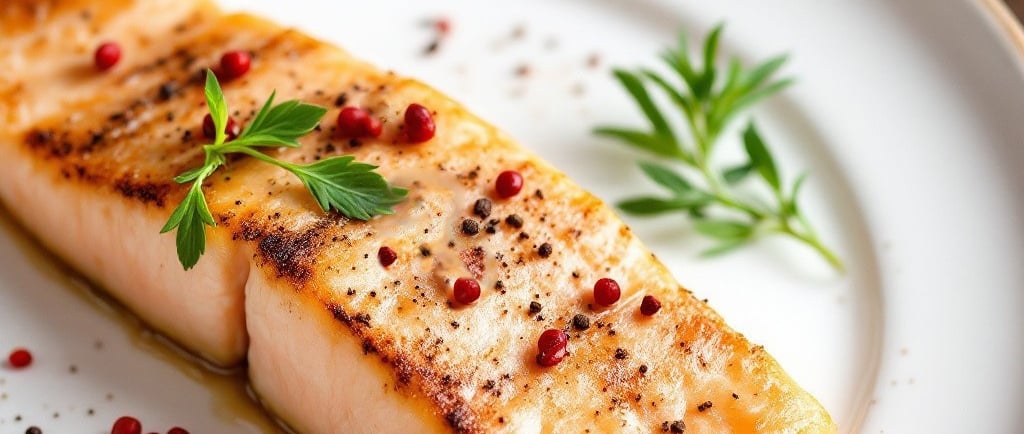Baked Trout
Historically, trout has been a mainstay for communities nestled around rivers and lakes, facilitating both sustenance and economic activity through fishing.
FISHPROTEINEASY TO MAKE
Lourdes Rodriguez
2/25/20255 min read


A Brief History of Trout: Cultural Significance
Trout, a freshwater fish belonging to the Salmonidae family, has served as a crucial component in various culinary traditions across the globe. Its significance extends beyond mere sustenance, as it encapsulates cultural practices and celebrations in diverse regions, particularly in Europe, North America, and parts of Asia. Historically, trout has been a mainstay for communities nestled around rivers and lakes, facilitating both sustenance and economic activity through fishing.
In Europe, trout fishing is steeped in tradition, with many countries honoring this fish through time-honored festivals and regional cuisines. Countries like Norway and France have long celebrated trout as part of their culinary identity, often featuring it in elegant dishes or simple rustic fare. The preparation methods vary widely across cultures, encompassing techniques such as grilling, smoking, or baking, each showcasing the fish’s delicate flavor. In France, for example, the classic “truite aux amandes” highlights the fish paired with almonds, embodying the French emphasis on fresh ingredients and subtle flavors.
In North America, trout holds an essential place in the diets of many Indigenous communities, who have utilized this fish in various traditional dishes for centuries. The rich ecosystems of North American rivers have supported a vibrant culture of fishing, where trout features prominently, symbolizing sustainability and respect for nature. Festivals that celebrate trout fishing often include community feasts, where families and friends gather to share meals made from their catch, reinforcing social bonds through shared culinary traditions.
Asian cultures also embrace trout, often incorporating it into their culinary practices. In Japan, for instance, trout is celebrated in seasonal delicacies, illustrating the connection between nature and cuisine. These cultural narratives surrounding trout not only highlight the fish's nutritional value but also reflect its role in fostering cultural identity and communal relationships through food.
Health Benefits of Baked Trout
Trout is a nutrient-dense fish that offers a multitude of health benefits, particularly when prepared through baking. This cooking method not only preserves the fish's delicate flavor but also maintains its impressive nutritional profile, making baked trout an excellent addition to a balanced diet.
One of the most significant advantages of consuming baked trout is its high content of omega-3 fatty acids. These essential fats play a crucial role in promoting heart health by lowering blood pressure, reducing triglycerides, and decreasing the risk of heart diseases. Additionally, omega-3 fatty acids are vital for optimal brain function, supporting cognitive development and potentially reducing the risk of age-related mental decline.
Trout is also rich in vital vitamins and minerals. Notably, it contains significant amounts of vitamin B12, which is essential for maintaining proper nerve function and producing DNA. Furthermore, trout is a good source of vitamin D, which is important for bone health and can enhance immune function. Other nutrients found in baked trout include selenium, phosphorus, and potassium, all contributing to overall well-being. Selenium, for instance, is known for its antioxidant properties and plays a role in metabolism and thyroid function.
When compared to methods such as frying or grilling, baking trout is particularly beneficial as it allows for the retention of these essential nutrients. These alternative cooking methods can often lead to the loss of healthy fats and vitamins due to high temperatures and added oils. By choosing baked trout, individuals can enjoy a delicious meal that supports heart health, boosts brain function, and enhances overall nutrition.
Baked Trout Recipe
Yield: 2 servings
Ingredients:
1 lb. of trout
1 tsp. Himalayan or Kosher salt
½ tsp. red peppercorn, crushed
1 Tbsp. tarragon
1 Tbsp. grapeseed oil
Instructions:
Preheat oven at 400°F/200°C.
Slightly coat the trout with a thin layer of oil, salt, and red peppercorn. Sprinkle the tarragon on top of the trout.
Bake the trout on a baking pan, place on the middle rack.
Bake for 12 to 15 minutes or until its internal temperature reaches 145°F/60°C.
Note:
Applying the fish with a thin layer of oil it will ensure that the internal juices of the fish will stay inside, allowing a much desirable tender texture. It is important to understand that cooking over medium-high/high temperatures a high smoke point oil most be use. Example of these oils are: avocado, grapeseed, peanut, sunflowers, etc. Oils with high smoke points will prevent the formation of free radicals in our food.
To prepare the fish, ensure that it is properly cleaned and scaled. Rinse the trout under cold water and pat them dry with paper towels. This step is crucial, as a dry surface allows the fish to roast evenly. Once cleaned, place the trout on a baking sheet lined with parchment paper for easy cleanup.
The cooking time may vary slightly depending on the size of the fish; trout is typically done when the flesh is opaque and flakes easily with a fork.
Serving Suggestions and Pairing Ideas
When serving baked trout, it is important to consider both complementary side dishes and beverages that can enhance the overall dining experience. Among the ideal side dishes, roasted vegetables, such as asparagus, Brussels sprouts, or bell peppers, not only add vibrant colors but also provide a delightful contrast in texture to the tender fish. A light, seasoned quinoa or a fluffy rice pilaf can also be a pleasing accompaniment, allowing the trout to shine as the star of the meal.
For those who enjoy a touch of freshness, a crisp garden salad made with mixed greens, cherry tomatoes, cucumber, and a light vinaigrette can elevate the dish. You may opt to add fruits such as citrus segments or berries to the salad for an unexpected burst of flavor. Furthermore, a creamy coleslaw with a hint of tanginess pairs beautifully with the subtleness of the trout.
Sauces can also play a pivotal role in enhancing the flavor profile of the baked trout. A simple lemon butter sauce, infused with herbs like dill or parsley, complements the fish perfectly, providing a rich yet zesty finish. Alternatively, a mango salsa or a tartar sauce can add a contemporary twist to your dish.
When it comes to beverages, consider serving a chilled white wine, such as Sauvignon Blanc or Chardonnay, both of which harmonize splendidly with the delicate flavors of trout. For non-alcoholic options, a sparkling water with a splash of lemon or a fruit-infused iced tea can refresh the palate and round out the meal.
Lastly, presentation can significantly impact the enjoyment of the dish. Plating the baked trout on a colorful plate, garnished with fresh herbs or lemon wedges, adds a touch of elegance that is sure to impress family and guests. By combining these serving suggestions and pairing ideas, you can create a memorable and delicious dining experience around your baked trout dish.
Reasons to Limit or Avoid Baked Trout:
Allergies to Fish: For individuals with a fish allergy, trout (like any other fish) should be avoided completely. Fish allergies can cause severe reactions, including anaphylaxis, which makes it essential to avoid any form of fish, including baked trout.
Kidney Health: Although trout is a healthy fish high in protein and omega-3 fatty acids, it is still a source of phosphorus and potassium, which individuals with kidney disease may need to monitor carefully. Too much phosphorus or potassium can put strain on the kidneys in those with renal issues.
Digestive Sensitivities: For people with sensitive digestive systems or irritable bowel syndrome (IBS), rich and oily fish like trout could cause bloating or discomfort. Fatty foods may sometimes exacerbate symptoms in those with gastrointestinal conditions.
Important: If you have any doubts about incorporating this food into your diet, it is always a good idea to consult with your dietitian or doctor.
Plenitaste
Inspiring healthy, global recipes for everyone.
contact me:
Recipe
plenitaste@gmail.com
© 2025. All rights reserved.
